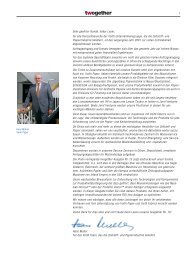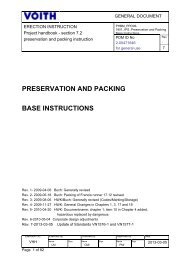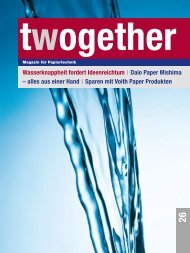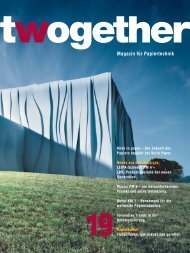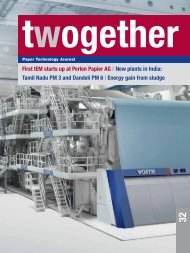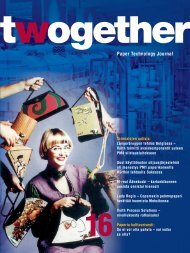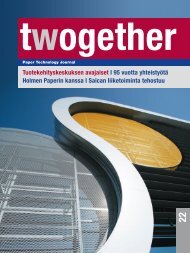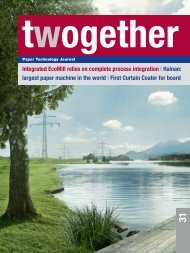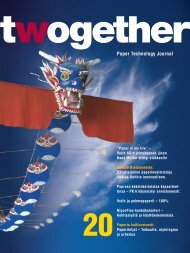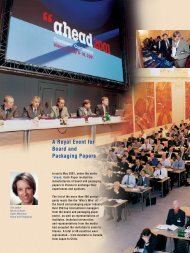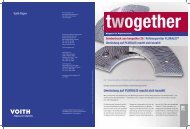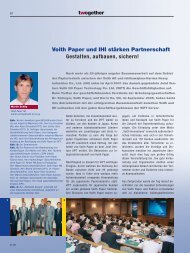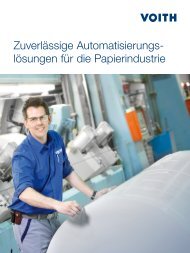Paper Technology Journal 19 - Voith
Paper Technology Journal 19 - Voith
Paper Technology Journal 19 - Voith
Create successful ePaper yourself
Turn your PDF publications into a flip-book with our unique Google optimized e-Paper software.
3<br />
4<br />
Method Operating Speed [m/min] Appeal on Consumers<br />
Direct Method 20 - 40 Good<br />
Gel Method 30 - 90 Superior<br />
Rewet I 50 - 200 Good<br />
Rewet II 30 - 100 Superior<br />
There are three representative production<br />
methods, which can be characterized and<br />
evaluated as shown in the table above.<br />
Key features of the<br />
cast coating technology<br />
Key of the cast coating process is to apply<br />
the coating color onto paper to<br />
achieve a hard, mirror-like surface while<br />
the coating color is still wet. After the application<br />
on the base paper the coating<br />
color is pressed against the cast coater<br />
cylinder in moist condition, which results<br />
in such extreme surface quality. Since<br />
gloss of cast coated grades tends to decrease<br />
with increased production speed<br />
and pin hole defects of the coat appear, it<br />
is extremely important to achieve higher<br />
speeds without such quality defects.<br />
It is essential to mainly discharge water<br />
vapor from the uncoated paper side, be-<br />
5<br />
cause if water vapor is discharged from<br />
the coating surface, pin holes can occur,<br />
influencing the printability and appearance<br />
of the surface. A further key point is<br />
to control moisture (omit excessive drying)<br />
and curling after the coated paper<br />
left the cast coater cylinder.<br />
There are various adjustment measures,<br />
such as application of a curling prevention<br />
agent onto the backside, application<br />
of steam to both sides or passing the paper<br />
through a hood with moisturized air.<br />
<strong>Voith</strong> IHI’s longterm experience and<br />
accumulated know is a solid foundation<br />
for serving the industry with whatever is<br />
required to improve the cast coating<br />
process.<br />
Required base paper properties<br />
For the base paper there are two main requirements:<br />
Porosity of the base paper is<br />
47<br />
Fig. 1: Examples for cast coated paper products.<br />
Fig. 2: <strong>Voith</strong> IHI pilot coater machines in Japan.<br />
Fig. 3: Cast coater cylinder from outside.<br />
Fig. 4: Cast coater drying section.<br />
Fig. 5: Moisturizing and reel section.<br />
important to allow the paper to transfer<br />
the moisture/vapor during the drying on<br />
the cast dryer drum. In addition, the base<br />
paper’s smoothness has a significant influence<br />
on the smoothness of the coated<br />
layer.<br />
Required coating color<br />
properties<br />
The properties of the coating color differ<br />
slightly according to the production<br />
process. However, the main common<br />
point is that the size of the pigment particles,<br />
the pigment mixing ratio, and the<br />
binder type and mixing ratio are important<br />
elements.<br />
Considering the market trends, this special<br />
coating technology will become even<br />
more important in the near future. Within<br />
the <strong>Voith</strong> <strong>Paper</strong> Group, <strong>Voith</strong> IHI will<br />
assume the role to continue the development<br />
of the cast coating technology<br />
together with the industry.<br />
We trust that even with the improvement<br />
of other coating technologies, the challenge<br />
of cast coating remains important<br />
to the industry and we would like to<br />
invite interested customer to develop<br />
together with us business chances in this<br />
specific coating field.<br />
<strong>19</strong>/05



